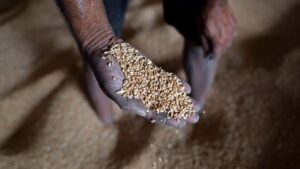PM-KISAN’s benefits are being extended to many who don’t deserve them, but they elude the needy

According to a statement made by the government in Parliament, the number of farmers receiving income transfers under the Pradhan Mantri Kisan Samman Nidhi (PM-KISAN) Scheme declined from 104 million during 2021-22 to 80 million during 2022-23. There has been a corresponding reduction in payments from Rs 67,032 crore during 2021-22 to Rs 57,646 crore in 2022-23.
Launched by Prime Minister Narendra Modi on February 24, 2019, and made effective from December 1, 2018, PM-KISAN is a central sector scheme. Under it, the Union government gives Rs 6,000 a year to each farmer with a valid enrolment. It is paid in three instalments of Rs 2,000 every four months. The money is credited to the farmers’ accounts via the Direct Benefit Transfer (DBT) mode.
Any landholding farm household is eligible for the scheme if they don’t pay income tax, hold any government post or don’t have a retiree receiving a pension above Rs 10,000. The cutoff date for the identification of the beneficiary — based on the Agriculture Census 2015-16 — was February 1, 2019. The number of farmers intended to be covered was about
140 million.
Having decided who should be eligible to receive the cash transfer, the number of beneficiaries can only increase as more farmers are added to the list. Unlike other schemes such as NREGA, where the number of beneficiaries is linked to the availability of work, under PM-KISAN, all farmers on the list, once decided, are entitled to receive the money. Why then is the number down?
It only points towards the fact that 24 million farmers were incorrectly identified and hence, ineligible to receive the assistance. During 2022-23, their names were dropped from the list and no payment was made; in the future also, they won’t receive any money. The government must ensure that it recovers all ineligible payments made during 2021-22 and before.
But the inclusion of ineligible persons in the very first place raises concern. The Centre claims that it has adopted a robust and foolproof IT-based process for identification and payment. The most crucial element is to confirm the genuineness of beneficiaries, which is the sole responsibility of the states. On close scrutiny, it turns out that in the initial years, they didn’t use Aadhaar for validation. It was done only after the Centre made it mandatory. By then, a large number of ineligible persons had made their way to the list.
While the benefit of the scheme is being extended to those who don’t deserve it, a huge number of those who deserve the aid are being denied it. When launched, the scheme was intended to help only small and marginal farmers (SMFs), those with landholding < 2 hectares, in procuring fertilisers, seeds, pesticides, etc.
Within six months, from June 1, 2019, its scope was extended to cover all landholding farmers. In other words, the government decided to give Rs 6,000 even to farmers with large landholdings. This meant an increase in the number of beneficiaries by 25 million and expenditure by Rs 15,000 crore. This money could have been used to give more support to SMFs, especially marginal farmers, i.e., those with landholding less than a hectare in sync with Modi’s philosophy of using national resources for the poorest of the poor.
In certain states, farmers don’t have access to the scheme. For instance, in Bihar, against a total of around 16 million, the state has uploaded a list of only 6 million. West Bengal hasn’t joined the scheme, thereby denying access to 7 million farmers. The Centre is now encouraging those farmers to apply directly on the portal.
The Centre has taken certain other initiatives to address the issues. The states that have achieved 90% coverage are required to verify 100% of 25 randomly selected villages in districts where the coverage is low. The states with a coverage of less than 80% need to verify 25 villages even in districts where the coverage is relatively high. Till these initiatives bear fruit, millions will continue to be denied the benefits under the scheme.
There is a big chunk of farmers who cultivate the land but don’t own it. But under the current arrangement, they are not eligible; instead, the money is sent to the account of the person who owns the land. This anomaly could be corrected only if the government had the data on all such tenant farmers. But it doesn’t.
The biggest worry of SMFs is a ridiculously low price for their produce (the recent episode of a farmer from Maharashtra’s Solapur getting a measly Rs 2.49 from the sale of 5 quintal onions still resonates), courtesy of shackled agri-markets under states’ APMC Act. The assistance given under PM-KISAN can’t make up for it, even remotely. All-out efforts are needed to unshackle agri-markets. The resurrection of three central farm laws should receive top priority.
(The writer is a policy analyst)
https://www.deccanherald.com/opinion/in-perspective/no-fertile-future-yet-for-farmers-scheme-1212376.html